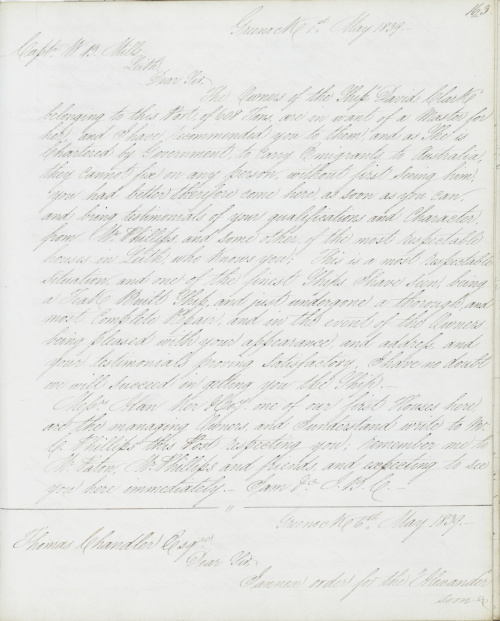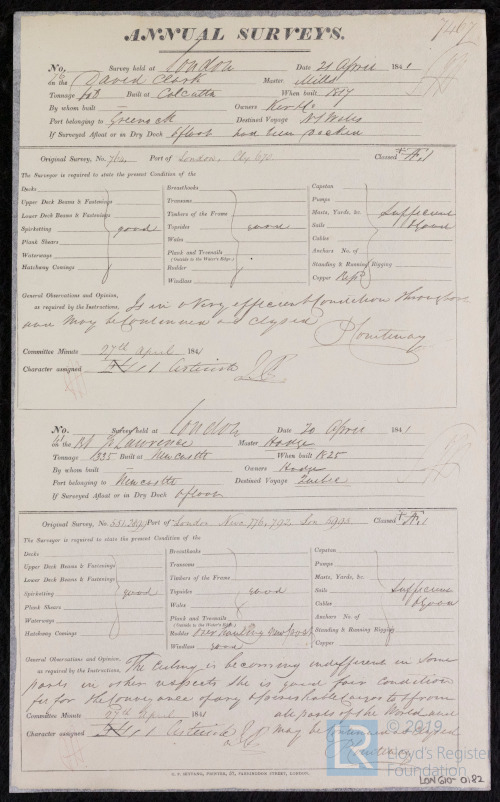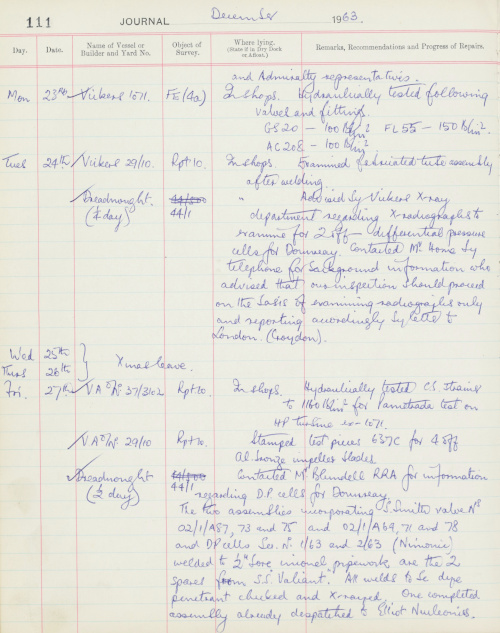Archives Hub feature for January 2023
In March 2022 the Heritage and Education Centre (HEC) for Lloyds Register (LR) began an inventory of the archive holdings as large parts of the collections currently remain uncatalogued. Part of this work has highlighted the individual experiences of some of the surveyor’s working for LR over a period of nearly 200 years in the form of surveyor letter books, notebooks, and journals. Alongside the related survey reports, plans and correspondence which make up a core part of both the archive and the historic work of LR we can provide an insight into these unique individuals and their roles.
Some of the earliest surviving accounts of surveyors we hold come from two surveyors based in Scotland, Walter Paton (Leith and Firth of Forth ports) and John Bar Cumming (Clyde Ports). Their letter books and journals span the years 1834-1850, they generally contain information and notes from their time surveying vessels which accompanies the information which was to be captured on the ship survey reports and subsequently included in the Register Books. They also reflect the changes in shipping within a steadily growing global industrial world as well as showing the lives of individuals operating within shipping. On several occasions Walter Paton explains his dissatisfaction with the unwillingness of local ship owners and builders to pay the survey fees. In one letter John Bar Cummings puts forward a suggestion for a master of a ship to accept a job taking immigrants to Australia.
The later survey report for David Clark shows that the person in question took this job.
Both these surveyors reference meeting and contacting each other throughout their correspondence, demonstrating the networks of officials operating across the United Kingdom, and internationally, with a centralised contact with the London Office.
Surveyors were initially selected from positions as shipwrights and sea captains, not only was this practical experience with the understanding of ship construction and maintenance relevant for the tasks at hand but it also prepared the surveyors for the dangers of life at sea, this can be seen by Walter Paton assisting with a shipwreck of the coast of Leith. Reflecting a theme that runs through the history of LR, safety at sea. The surveyors often worked long hours and in the early days had limited holidays. As a letter book for John Bar Cummings shows, the work-life balance of some of the surveyors from this time was fraught with difficulty. Usually working the Christmas period, Cummings luckily had one holiday on Saturday 1st of January 1848 due to closed offices!
The early ship survey reports often included additional information on the ship owners, ship builders, the vessel themselves or comments on events and activities at the port of survey. These often go hand in hand with the letter books and journals. The survey report for Hecla states that the vessel was thoroughly overhauled and fitted out as a whaling ship, for the now famous Northern expedition under Captain William Edward Parry, but that originally, she had been built as a bomb vessel for the Royal Navy.
Some of the later accounts of surveyors we hold provide less of a personal insight, but they do reveal how technology and industry were changing and the specialised knowledge that was required to undertake their roles. N H Burgess surveyor notebooks from the late 19th and early 20th century include various detailed diagrams and calculations and lists the safe number of staff that should be on any given ship at one time. Again, reflecting the continued theme of safety at sea within the work of the surveyors. Likewise, the Surveyor notebooks for S Archer from 1942 onwards contain various tables, diagrams, and calculations. Together they show the engineering, scientific and mathematical capabilities required for surveying in the first half of the 20th century. More information on these surveyors can be found listed on the ‘List of Surveyors’ (1) available on our website and found in the Lloyd’s Register of Ships.

The surveyor journal for Bill Blacklock for 1962-1964, around South Shields, Liverpool and Middlesborough, reflects a great change in the global approaches towards energy and fuel. He was one of the surveyors to have worked on the HMS Dreadnaught, the UK’s first nuclear powered submarine.
The notebooks of surveyor John Mansfield covering the 1980s contain multiple volumes from his tenure at the then Machinery Design and Plan Approval Department. In addition to working for plan approval in London he was also positioned in Hamburg. They are typically representative of surveyors work from the time and detail the activities on the ground for the surveying staff. The notebooks include detailed diagrams, calculations and notes on engineering and shipbuilding, including extracts from letters and discussions for rules and regulations. In the case of the letter below, comments extended to the inspection of onboard CO2 fire extinguisher cannisters.
From surveying artic exploration vessels and shipwrecks, to inspecting nuclear powered vessels, these records offer unique insights into the working lives of the Lloyd’s Register Surveyor on sea and on land.
As noted above not all our collections are currently catalogued and searchable online, as our inventory and archival site mapping work progresses, HEC aims to make as much of this material freely and publicly accessible. HEC is currently closed for refurbishments, for further information on our archives, and access the ship plan and survey report, register books and list of surveyors please visit our online catalogue.
Zach Schieferstein, Archive Officer
Heritage & Education Centre
Lloyd’s Register Foundation
Related
(1) Lloyd’s Register List of Surveyors 1942-1947: Lloyd’s Register Foundation, Heritage & Education Centre: Free Download, Borrow, and Streaming : Internet Archive
Browse the Lloyd’s Register Foundation, Heritage and Education Centre descriptions to date on Archives Hub
All images copyright LRF heritage and education centre. Reproduced with the kind permission of the copyright holders.







